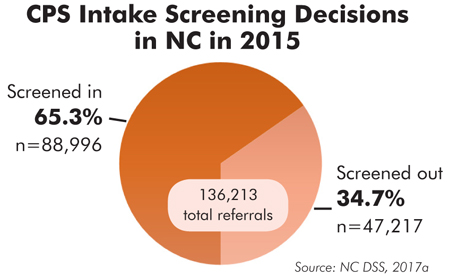 |
 |
 |
Vol.
22, No. 2
April 2017
Decision Making and Documentation at CPS Intake
Child protective services intake is a key part of how we protect children. It's where we begin collecting information and making initial decisions about child safety. Documentation begun at intake continues throughout the family's involvement with the agency and can play a critical role in the court process.
Screening Decisions
The first decision to be made at intake is whether a referral meets the criteria for a response from CPS. If it doesn't, the referral is "screened out." If it does, it is "screened in" and a CPS assessment is initiated.
During federal fiscal year 2015, CPS agencies in the U.S. received an estimated 4 million referrals. Among the 44 states that reported both screened-in and screened-out referrals, 58.2% of referrals were screened in and 41.8% were screened out. The performance of individual states varied. For example, 15 states screened in more than the national percentage, with screen-in rates ranging from 60.7% to 98.4% (USDHHS, 2017). This variation is due in part to differences in state policies.
In 2015 in North Carolina, referrals were somewhat more likely to be screened in than the national average. According to the NC Division of Social Services Child Welfare Workforce Data Book there were 136,213 child maltreatment referrals in 2015. Of these, 88,996, or 65.3%, were screened in (NC DSS, 2017a).

Since 65.3% is a statewide average, the screen-in rate was above or below this in most counties. Rates outside the norm (above or below) should cause counties to stop and ask deeper questions to be sure they understand the reason for their performance. (Counties provide this data quarterly to the Division and they have their own performance available to them.)
Intake: Monitoring Team Insights
Insights from the NC Division of Social Services' Child Welfare Monitoring Team suggest CPS intake in NC might be strengthened. While the job of the Monitoring Team is to provide technical assistance to counties, as part of their work Monitors select and read agency records to understand whether an agency's practice is in keeping with mandated standards. Although the Monitoring Team's findings can't be generalized statewide (e.g., they are based on a non-random sample), they are of interest to agencies seeking to strengthen their practice, including CPS intake practice.
In 2016 the Division's Monitors reviewed approximately 1,800 referrals for alleged child maltreatment. They found 93% of referrals that were screened in were done so according to policy (NC DSS, 2017b).
The picture was slightly different for screen-outs. Of these, 82% were screened according to policy. Of the records that included a written justification for the screen-out decision, a third of the time the justification was insufficient. Often it merely stated the allegation did not meet the statutory definition of abuse/neglect or dependency and did not include details unique to the referral (NC DSS, 2017b).
Initiation: CFSR Findings
Agency follow-through after reports are screened in also matters. In the 2015 Child and Family Services Review (CFSR), federal reviewers found timeliness of initiating investigations of reports of child maltreatment (Safety Item 1) an area needing improvement in our state. Federal reviewers found shortcomings in 25% of the case records they reviewed, including "insufficient diligent efforts by caseworker to initiate within timeframe" and "delay in assigning/writing/screening intake report" (USDHHS, 2016).
When they looked at initiation, Monitors also found that just 75% of the screened-in reports they reviewed in 2016 were initiated according to policy. Often the agency did not conduct face-to-face interviews with all children living in the home within the required timeframe. When they failed to see and interview children in timeframe, agencies documented their diligent efforts to do so only 33% of the time (NC DSS, 2017b).
Implications
Documentation matters. The CFSR results and Monitoring Team findings shared above underscore how important it is for documentation to paint a clear picture of what the agency knows, what it decides based on that information (even when screening out), and the actions the agency takes based on its decisions. Poor documentation effectively erases good social work; this in turn can lead to inappropriate decisions down the line, and to poor family outcomes.
Know and follow policy. The findings we've discussed also suggest some agencies do not always follow policy. NC policy requires the use of the Structured Intake Form (DSS-1402) and offers extensive guidance and resources, including decision trees for screening various types of child maltreatment, domestic violence, human trafficking, and more.
CPS assessment policy calls for agencies to interview (not just see) all children living in the home at initiation so the agency can adequately assess the allegations and the safety and well-being of the children.
Support for You and Your Agency
Thousands upon thousands of CPS referrals are made each year in our state. Each concerns a North Carolina child. County child welfare agencies are responsible for screening and responding--sometimes in partnership with each other--to these referrals to ensure the safety of these children.
The NC Division of Social Services wants to support you and your agency with this challenging task. As part of this support, the Division offers the courses Intake in Child Welfare Services and CPS Assessments at locations throughout the state on an ongoing basis. In addition, the Division offered a webinar about CPS intake and initiation in February 2017. You can register for these courses and watch a recording of this webinar by visiting the main page of the Division's online learning portal for child welfare professionals, ncswLearn.org.
References for this and other articles in this issue
To Avoid Common Erors at CPS Intake/Initiation . . . |
Source: NC DSS, 2017b |
